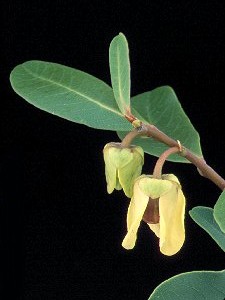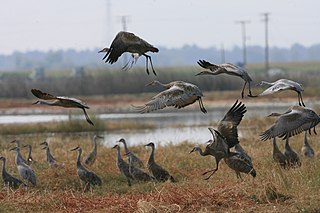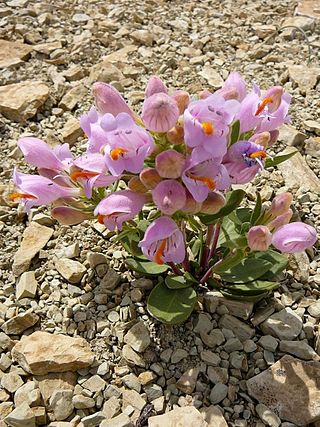
In agriculture, rotational grazing, as opposed to continuous grazing, describes many systems of pasturing, whereby livestock are moved to portions of the pasture, called paddocks, while the other portions rest. Each paddock must provide all the needs of the livestock, such as food, water and sometimes shade and shelter. The approach often produces lower outputs than more intensive animal farming operations, but requires lower inputs, and therefore sometimes produces higher net farm income per animal.

The longleaf pine is a pine species native to the Southeastern United States, found along the coastal plain from East Texas to southern Virginia, extending into northern and central Florida. In this area it is also known as "yellow pine" or "long leaf yellow pine", although it is properly just one out of a number of species termed yellow pine. It reaches a height of 30–35 m (98–115 ft) and a diameter of 0.7 m (28 in). In the past, before extensive logging, they reportedly grew to 47 m (154 ft) with a diameter of 1.2 m (47 in). The tree is a cultural symbol of the Southern United States, being the official state tree of Alabama. This particular species is one of the eight pine tree species that falls under the "Pine" designation as the state tree of North Carolina.

Bromus tectorum, known as downy brome, drooping brome or cheatgrass, is a winter annual grass native to Europe, southwestern Asia, and northern Africa, but has become invasive in many other areas. It now is present in most of Europe, southern Russia, Japan, South Africa, Australia, New Zealand, Iceland, Greenland, North America and western Central Asia. In the eastern US B. tectorum is common along roadsides and as a crop weed, but usually does not dominate an ecosystem. It has become a dominant species in the Intermountain West and parts of Canada, and displays especially invasive behavior in the sagebrush steppe ecosystems where it has been listed as noxious weed. B. tectorum often enters the site in an area that has been disturbed, and then quickly expands into the surrounding area through its rapid growth and prolific seed production.
Natural Resources Conservation Service (NRCS), formerly known as the Soil Conservation Service (SCS), is an agency of the United States Department of Agriculture (USDA) that provides technical assistance to farmers and other private landowners and managers.

The Sandhills, often written Sand Hills, is a region of mixed-grass prairie on grass-stabilized sand dunes in north-central Nebraska, covering just over one quarter of the state. The dunes were designated a National Natural Landmark in 1984.

Fire ecology is a scientific discipline concerned with the effects of fire on natural ecosystems. Many ecosystems, particularly prairie, savanna, chaparral and coniferous forests, have evolved with fire as an essential contributor to habitat vitality and renewal. Many plant species in fire-affected environments use fire to germinate, establish, or to reproduce. Wildfire suppression not only endangers these species, but also the animals that depend upon them.

California coastal prairie, also known as northern coastal grassland, is a grassland plant community of California and Oregon in the temperate grasslands, savannas, and shrublands biome. This ecosystem is found along the Pacific Coast, from as far south as Los Angeles in Southern California to southern Oregon. It typically stretches as far inland as 100 km, and occurs at altitudes of 350 m or lower.

Schwalbea americana, commonly known as American chaffseed, is the sole species currently classified in the genus Schwalbea. It is an erect, hemiparasitic, perennial herb in the family Orobanchaceae. It is native to the southeastern United States where it is found in wet acidic grasslands. This species has declined tremendously from its historical range due to fire suppression, development and collection, and it is currently listed as an endangered species by the U.S. Fish and Wildlife Service.

Asimina tetramera, commonly known as the four-petal pawpaw, is a rare species of small tree or perennial shrub endemic to Martin and Palm Beach Counties in the state of Florida. The species is currently listed as endangered under the Endangered Species Act and as endangered by the International Union for Conservation. The four-petal pawpaw is part of the family Annonaceae alongside other Asimina species.

The shortgrass prairie is an ecosystem located in the Great Plains of North America. The two most dominant grasses in the shortgrass prairie are blue grama and buffalograss, the two less dominant grasses in the prairie are greasegrass and sideoats grama. The prairie was formerly maintained by grazing pressure of American bison, which is the keystone species. Due to its semiarid climate, the shortgrass prairie receives on average less precipitation than that of the tall and mixed grass prairies to the east.

Arctostaphylos confertiflora is a rare species of manzanita known by the common name Santa Rosa Island manzanita. This shrub is endemic to California, where it grows on the sandstone bluffs of Santa Rosa Island in the Channel Islands. This manzanita is listed as an endangered species by the United States Government.
Private landowner assistance program (PLAP) is a class of government assistance program available throughout the U.S. for landowners interested in maintaining, developing, improving and protecting wildlife on their property. Each state provides various programs that assist landowners in agriculture, forestry and conserving wildlife habitat. This helps landowners in the practice of good land stewardship and provides multiple benefits to the environment. Some states offer technical assistance which includes:

Camissonia benitensis is a species of evening primrose known by the common names San Benito suncup and San Benito evening primrose. It is endemic to the Diablo Range of the South Coast Ranges of California, where its range includes far southern San Benito County, far western Fresno County, and far eastern Monterey County.
The San Luis National Wildlife Refuge Complex is located in the northern San Joaquin Valley, within Merced County and Stanislaus County of California. The complex, with four federal National Wildlife Refuges, is managed by the U.S Fish & Wildlife Service.
The Bonny Doon Ecological Reserve is a nature preserve of 552 acres (2.23 km2) in the Santa Cruz Mountains of California, United States. The reserve protects several rare and endangered plant and animal species within an area known as the Santa Cruz Sandhills, an ancient seabed containing fossilized marine animals.

The Merced National Wildlife Refuge encompasses 10,262 acres (41.53 km2) of wetlands, native grasslands, vernal pools, and riparian areas in California. It was established in 1951 under the Lea Act to attract wintering waterfowl from adjacent farmland where their foraging was causing crop damage. In the last few decades, changes in agricultural practices and refuge management have reduced these wildlife/crop issues.

Invasive species are a crucial threat to many native habitats and species of the United States and a significant cost to agriculture, forestry, and recreation. An invasive species refers to an organism that is not native to a specific region, this poses significant economic and environmental threats to its new habitat. The term "invasive species" can also refer to feral species or introduced diseases. Some introduced species, such as the dandelion, do not cause significant economic or ecologic damage and are not widely considered as invasive. Economic damages associated with invasive species' effects and control costs are estimated at $120 billion per year.

Astragalus microcymbus is a species of flowering plant in the legume family known by the common name skiff milkvetch. It is endemic to Colorado in the United States, where it is known from Gunnison County and the edge of Saguache County. It was discovered in 1945 by Rupert Barneby, a British botanist. Currently, skiff milkvetch is experiencing population declines and is listed as a Tier 1 species in the Rare Plant Addendum to the Colorado State Wildlife Action Plan.

Penstemon grahamii, known by the common names Uinta Basin beardtongue and Graham's beardtongue, is a species of flowering plant in the plantain family. It is native to Utah and Colorado in the United States.
Milk River Natural Area is a provincially designated protected area in the southeastern corner of the province of Alberta, Canada, approximately 160 km south of the city of Medicine Hat. It lies primarily in the County of Forty Mile with a small portion in southwest Cypress County. On the Alberta Township System (ATS) grid it is located in portions of Township 1, Range 5 and 6, and Township 2, Range 6, west of the Fourth Meridian.
















